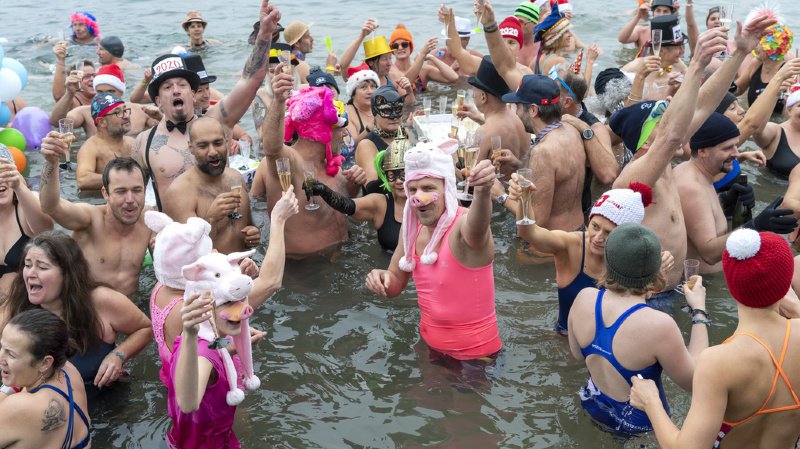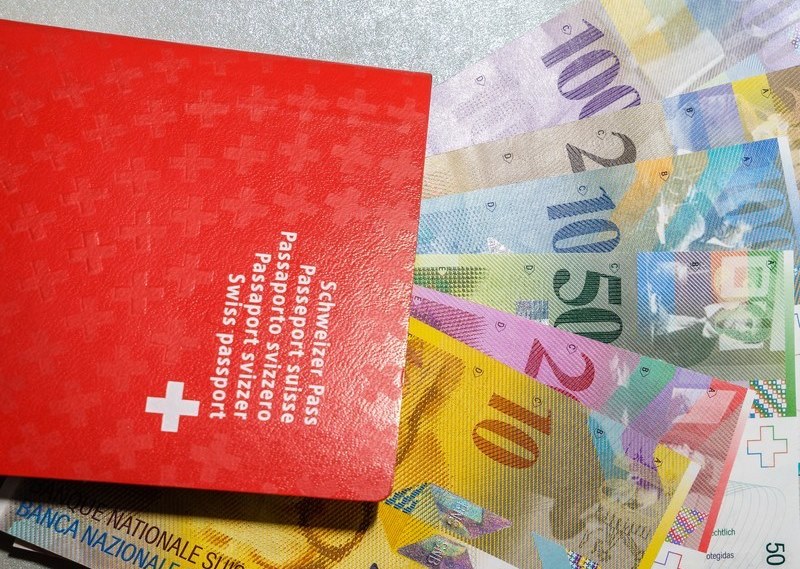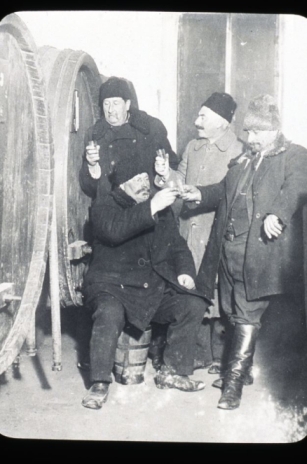Every 3rd Sunday in June, Swiss Chabagians and their descendants gather in the countryside near Lausanne to make chachlik – a traditional marinated, spit-roasted and stewed meat dish from Chabag. The elders greet each other in Russian, French, Romanian and German while their grandchildren rush to play football on the sunlit pitch outside. The Chabag Society has organised this yearly event for over 6 decades and I’m quickly introduced to a Mr. Jaton with a strong Russian accent and a Mr. Gavriliuc who is obviously a native Swiss-French speaker. Everyone has a movingly poignant story to tell about Chabo, the beloved home they were forced to leave in the chaos of WWII and its aftermath. Chabag was more than a town with a majority of Swiss citizens, as were Nova Friborgo in Brazil or Nueva Suiza in Argentina.
Populated exclusively by Swiss in the heart of Tsarist Russia, Chabag Colony was both politically autonomous and exempted from many Imperialist constraints. A group of 30 intrepid Swiss colonists were persuaded to emigrate half-way across Central Europe by Tsar Alexander I’s Swiss military advisor, Frйdйric-Cйsar de la Harpe. Just 8 families (including women and children) set out from Vevey in 1822 and brought their ancestral knowledge of wine making to the shores of the Black Sea. It took the Vaudois colonists 3 months to make the 2,200 km journey from Switzerland’s Lavaux wine region to their new home on the Liman of Dniester, a lagoon approximately 50 km from Odessa. Bessarabia had previously been part of the Ottoman Empire until it was ceded to Imperial Russia following the Russo-Turkish War (1806–1812) and Chabag’s very name is drawn from Acha- Abag, a Turkish expression meaning 'the gardens below’. Tsar Alexander I granted the abandoned Ottoman vineyards to his Swiss colonists, thereby populating his new lands with settlers who were both loyal Imperialists and capable of carrying on the area’s traditional viticulture. It’s hard to believe that these Vaudois chose to leave what is now a stunningly beautiful UNESCO World Heritage Site for the long trek to an unknown land under Imperial rule, diametrically opposed to their highly democratic Swiss political principles. However improbable it may seem today, the poor living conditions in Switzerland following the Swiss Revolution of 1789 were extremely influential. The burgeoning colony may have experienced some difficulties over the first few decades of its existence but Switzerland had been plagued by political upheaval, famine and various epidemics throughout the 17th and 18th Centuries.
Swiss settlers were therefore prepared to overcome the many hardships that befell them in their new Russian home and hundreds of French and German-speaking colonists left Switzerland to follow in the footsteps of Chabag’s founding families. By the 1850s, there were over 250 Swiss nationals living in the Tsar’s Helvetic haven – a population which had swelled to over 800 citizens in 1940 when the tragic events of WWII forced Chabagians of Swiss descent to flee for their lives. The early Swiss settlers were incited to make the move by the many privileges Tsar Alexander I granted his new colonists. These included freedom of religion, complete self-governance and exemption from Russian military service among many other unique liberties. Chabag was a truly politically autonomous colony with its own laws, prisons, judges and school system until 1870. In exchange for the Tsar’s largesse, the Swiss colonists were required to take the following oath: “We swear to be faithful to His Majesty the Emperor, Autocrat of all Russias, and the Achabag community of which we are members, to provide the benefit and profit, to bear all charges when we are required, and to be faithful in our management of the community for responsibilities left in our charge”. Most of the Swiss colonists were experienced winemakers and Chabag’s sandy terrain was ideal for growing grapes. The Vaudois brought Swiss grape varieties – including Lavaux’s famous Chasselas – from Switzerland to plant alongside the neglected Turkish vineyards they had been granted by Imperial ukase.
Chabag’s excellent wines soon made it one of the most prosperous colonies in Greater Russia and although many Chabagians retained their Swiss passports, they actively participated in Russian culture and politics. An early Chabagian colonist, Louis-Vincent Tardent, was friendly with Alexander Pushkin and Virgile Schanzer, who was directly descended from one the colony’s founding families, became Lenin’s trusted aide de camp and took part in the Moscow Revolt of 1905. Shortly after the Russian Revolution, the Treaty of Versailles (1919) ceded Chabag to Romania and conditions quickly deteriorated with the dramatic drop in wine prices. The Chabag Colony’s last Swiss citizens were driven out by Stalin’s Red Army in the early 1940s and those who weren’t deported to Siberia were considered ‘foreigners’, subjected to a variety of harsh discriminatory measures. Most of the colonists caved under Soviet pressure and fled to Switzerland, albeit reluctantly. Mr. Victor Jaton, who arrived in Lausanne aged 19 in 1945, explained, “Chabo was a like a big family and everyone was extremely close; it was a town filled with aunts, uncles and cousins. Our lifestyle was based on trust, community ethics and Slavic hospitality. The Swiss didn’t understand our traditions – we found their attitudes and principles to be very different from our own...” Mr Jaton hastened to add that, “We were grateful to return to Switzerland, the homeland we had never seen. I had tears in my eyes the first time I saw chalets and mountains... I was overwhelmed by the country’s wealth and modern luxuries as we didn’t have electricity or running water back in Chabo.”
Many families spoke either French or German at home and 5 generations of Chabagians were taught French in the local school. Some aspects of Swiss culture were also familiar as the rift between Swiss-German and French speakers was present even in Chabag, exemplified by a heated debate over whether a German cross or a French rooster should top Chabag’s church spire. The colony eventually decided to integrate the two symbols, thereby satisfying both camps. Mr. Georges Dogny, President of the Chabag Society for 47 years, and I spoke of his childhood memories over our chachlik. Mr. Dogny described how Chabagians who returned to Switzerland were so homesick that they rapidly founded the association in 1947. These Swiss were native Russians or Romanians in their hearts and desperate to retain some ties to the home they were forced to flee. They longed for the lifestyle they had left behind in their beloved Chabo and numerous young Chabagians soon inter-married in Switzerland.
But the Chabag Society’s ties to their native colony remained constant, as did their yearly reunions – even during its dark years behind the Iron Curtain when Chabag was literally cut off from the West. It wasn’t until Gorbachev’s glasnost that Chabag Society members were able to organise a visit to their old Eastern European home. They finally made the journey in 1988, accompanied by a few of their Swiss-born descendants who had never seen Chabag but had heard stories about the lost colony all their lives. Many Swiss Chabagians joyfully fell into the arms of friends and relatives who had stayed in the East but were shocked to find virtually no traces of the Chabag they had left behind. Entire neighbourhoods had disappeared, the school had been torn down and their church had become a cinema club for viewing political films. Streets that had once been called rue Helvetia or Grand’ Rue were unrecognisable and had been renamed. Even the town’s traditional Swiss wine cellars had all but disappeared, destroyed by Soviet efforts to eradicate alcohol abuse. The returning colonists were distressed to realise that their fond childhood memories were practically all that remained of what had once been the Tsar’s Swiss colony.
Although Chabag Colony was eradicated in the East, its memory lives on in Switzerland today. In late 2010, the first Chabag Festival – dedicated to the courageous Vaudois who founded Chabag – was held in Chexbres, just outside Vevey. Activities included a lecture on the colony, concerts and films as well as an exhibit presenting the history of Chabag – all of which served to inform the local community about their ancestral ties to the East. Swiss Chabagians take comfort in the fact that Chabag’s wines continue to be prized so long after their colony was disbanded. As Chabag later became a Soviet army base, the local wines were widely distributed and even supplied Soviet nuclear submarines. In 1988, Chabo’s sovkhoz was producing 8 million litres of wine yearly, including its award-winning ‘Blanc de Chabo’. The Swiss colony’s influence lingers on in every bottle of Chabagian wine and Mr. Jaton was proud to tell me that, “We made our mark on Chabo and wine is our legacy”.
Bibliography: www.chabag.ch
Olivier Grivat, Les Vignerons suisses du Tsar, Editions Ketty et Alexandre, Chapelle-sur-Moudon, 1993
Many thanks to the Chabag Society for their generous hospitality













